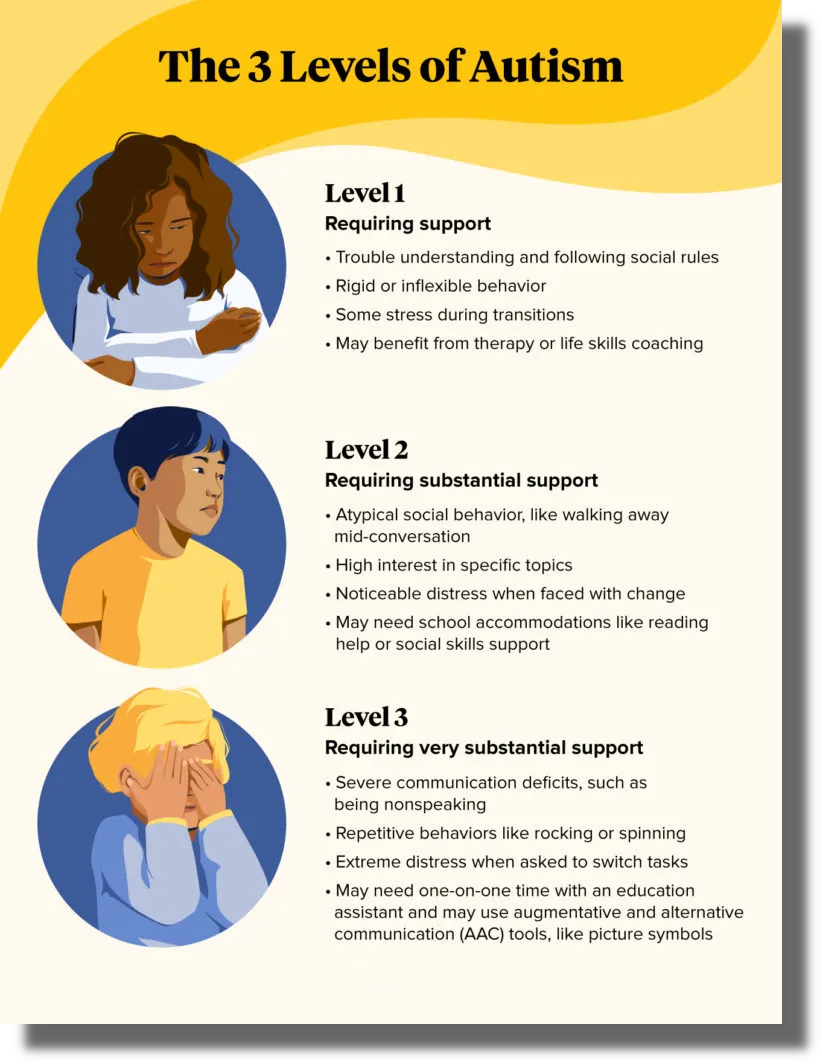Discovering Reliable Strategies for Sustaining Individuals With Behavior Autism
Supporting individuals with behavioral autism calls for a nuanced understanding of their distinct needs. You'll find that individualized treatments, grounded in evidence-based techniques, can make a significant distinction. By working together with households and professionals, you can create a customized method that fosters interaction and growth. Yet what specific strategies can you apply to ensure these individuals grow? Let's explore the efficient approaches that can boost their daily experiences.
Understanding Behavioral Autism: Secret Qualities and Difficulties
When you begin to understand behavioral autism, you'll discover several key attributes and obstacles that specify the experience for individuals. Lots of people with behavioral autism usually struggle with interaction, making it challenging for them to express their feelings or needs effectively. You might observe repeated actions, such as hand-flapping or shaking, which serve as coping mechanisms for managing stress and anxiety or sensory overload. Social communications may be testing; people may locate it difficult to review social hints, resulting in misunderstandings in relationships.
In addition, sensory level of sensitivities are typical, causing discomfort in atmospheres with brilliant lights or loud sounds. These difficulties can cause anxiety or disappointment, influencing life. It is necessary to recognize that each person is special, and their experiences might differ. Understanding these features allows you to come close to assistance with empathy, fostering a favorable connection that can improve their health and urge growth.
The Significance of Personalized Interventions
When it concerns sustaining individuals with behavior autism, personalized interventions are essential. By developing tailored treatment plans that concentrate on individual staminas, you can greatly boost their growth. Working together with support teams guarantees everybody is straightened in providing the most effective treatment possible.
Customized Intervention Strategies
Creating customized intervention strategies is important for properly sustaining people with behavioral autism, as each person's requirements, obstacles, and toughness differ substantially. Start by gathering comprehensive information about the person, including their preferences, causes, and previous experiences. This adaptability not just fosters interaction yet also promotes a feeling of possession and empowerment for the person.
Private Strengths Assessment
An individual strengths analysis is essential for creating personalized interventions for people with behavioral autism. By focusing on each person's special capabilities, you can produce approaches that reverberate with their rate of interests and skills. This strategy not only improves engagement however additionally boosts self-confidence.
When you identify staminas, like extraordinary memory or artistic ability, you can customize interventions that leverage these locations. This not only makes finding out more efficient however also promotes a feeling of success. Keep in mind, every individual has unique capabilities; recognizing them encourages you to craft purposeful experiences.
Including these strengths right into healing methods and daily routines can cause enhanced results. Inevitably, prioritizing toughness warranties that interventions are not just effective yet additionally enriching for the individual.
Collaborative Assistance Teams
Identifying specific toughness establishes the phase for creating collaborative assistance teams that concentrate on tailored treatments. By uniting experts, member of the family, and the people themselves, you produce a helpful network that customizes approaches to satisfy certain requirements. Each employee contributes unique insights, making certain an extensive method that attends to behavioral challenges efficiently.
This flexibility is essential, as it helps everyone involved keep aligned with the person's preferences and objectives. Additionally, engaging in this team-based technique encourages individuals with autism, promoting their self-advocacy and confidence.
Evidence-Based Interaction Techniques

When dealing with individuals on the autism range, utilizing evidence-based communication strategies can greatly boost their ability to link and express themselves. Making use of visual supports, like picture routines or communication boards, aids clear up assumptions and promotes self-reliance. Streamlining language and utilizing concrete terms enables much better understanding, minimizing irritation.
Including social stories can prepare people for different scenarios, teaching them appropriate responses and habits. Urging the usage of assistive modern technology, such as speech-generating tools, equips individuals to connect better. Additionally, employing foreseeable atmospheres and consistent routines can provide a feeling of security, making interaction extra effective.
Remember to be client and provide time to process your words. Engaging in active listening, where you show their thoughts and sensations, can reinforce your connection. By executing these strategies, you'll produce an extra supportive communication atmosphere for individuals with autism.
Creating Encouraging Atmospheres
Producing helpful settings for individuals with behavior autism begins with applying organized regimens that supply predictability and protection. You'll also wish to make sensory-friendly rooms that accommodate specific requirements, reducing overwhelming stimulations. In addition, utilizing positive reinforcement techniques can urge preferred behaviors and cultivate a sense of achievement.
Structured Regular Implementation
Establishing a structured routine can considerably boost the environment for people with behavioral autism. By developing a regular schedule, you offer predictability, which can decrease anxiety and complication. Begin by damaging the day right into convenient sections, including tasks like meals, play, and silent time. Use visual timetables or timers to help them comprehend what follows. Ensure to include possibilities for breaks, as these can help them redouble and collect yourself. It is very important to be adaptable; while routines are beneficial, adapting to modifications in mood or conditions is important. Encourage participation in establishing the routine, so they really feel a feeling of ownership and control. A well-structured environment fosters independence and confidence, supporting their overall growth.
Sensory-Friendly Spaces Design

Positive Support Strategies
When you include favorable reinforcement methods right into your method, you can considerably improve the understanding and behavioral results for people with autism. Begin by identifying what encourages the private-- be it commend, symbols, or special activities. You can also progressively increase the complexity of tasks as individuals end up being a lot more comfy, strengthening their progression.
Collective Techniques: Collaborating With Households and Professionals

Including family members in decision-making equips them and enhances their capability to support their enjoyed ones. Professionals, including educators and specialists, can give useful sources and training that even more assist families.
You must additionally respect each event's perspective, recognizing that households know their kid ideal while specialists bring specialized expertise. By crafting personalized strategies with each other, you create a tailored technique that resolves unique needs. Aba Therapist. Inevitably, this partnership not just benefits the individual with autism but likewise reinforces the support network bordering them, making it a lot more cohesive and efficient
Incorporating Social Skills Educating
Structure on the solid collaborations formed between specialists and households, integrating social skills training can substantially boost the assistance supplied to people with behavioral autism. This training aids you educate essential interaction skills, such as launching discussions, understanding non-verbal hints, and reacting appropriately in social scenarios.
By utilizing organized activities, role-playing, and real-life circumstances, you produce chances for method in a safe news setting. Encourage people to join team settings where they can engage with peers, fostering relationships and enhancing their convenience in social contexts.
It is necessary to tailor the training to each individual's distinct staminas and challenges, ensuring they really feel confident and qualified. Routinely including comments from both families and professionals can refine these techniques, making social abilities educating much more effective. Inevitably, you're empowering individuals with the tools they need to navigate social communications successfully and construct significant relationships.
Keeping An Eye On Progression and Adjusting Strategies
As you apply social skills training, it's critical to monitor development and readjust strategies appropriately. Keep an eye on behaviors, keeping in mind troubles and improvements. Usage devices like graphes or checklists to imagine growth and recognize patterns. Frequently assess your observations to assess what's working and what isn't.
Engage the individual in reflection, asking how they feel regarding their development and what difficulties they encounter. This responses is important for tailoring your approach. Do not think twice to customize them. if particular approaches aren't producing results.
Work together with other caretakers or experts for fresh perspectives and understandings. By staying responsive and alert, you create a setting that promotes growth and advancement.
Regularly Asked Concerns
What Are the Common Misconceptions Regarding Behavioral Autism?
You may assume behavior autism just affects communication, yet it includes a lot more. Many believe all people with autism act the exact same, ignoring their special traits and capabilities. It's necessary to understand each individual's distinctions.
Just How Can Modern Technology Assist in Sustaining People With Behavioral Autism?
Modern technology can enhance communication, supplying devices like apps for social abilities and behavior monitoring. You can use virtual reality web for immersive experiences, and wearable gadgets can monitor emotional states, helping you support people properly.
What Role Do Sensory Handling Issues Play in Behavioral Autism?
Sensory handling issues can substantially affect habits. You might see that overwhelming sensory input results in stress and anxiety or disasters. Understanding these difficulties assists you develop an extra supportive atmosphere for individuals experiencing sensory overload.
Are There Certain Dietary Suggestions for Individuals With Behavioral Autism?
Yes, particular dietary referrals can aid. You may take into consideration a gluten-free or casein-free diet plan, which some find valuable (Aba Therapist). Constantly get in touch with a healthcare professional prior to making significant adjustments to assure it's best for you or your liked ones
Exactly How Can Peers Be Informed to Support People With Behavioral Autism?
To educate peers, you can organize workshops, develop interesting materials, and encourage open discussions. Engaging tasks, like role-playing situations, help them understand obstacles dealt with by individuals, fostering empathy and effective assistance within the neighborhood.
Exploring Efficient Approaches for Supporting People With Behavioral Autism.
Producing customized intervention strategies is crucial for efficiently supporting people with behavior autism, as each individual's challenges, requirements, and toughness differ significantly.A specific strengths analysis is vital for creating personalized interventions for people with behavior autism.To sustain individuals with behavioral autism, developing sensory-friendly areas is essential, as it can substantially boost their comfort and emphasis.Joint methods are essential for supporting people with behavioral autism, as they cultivate a solid partnership between households and professionals.